“Our indicators tell us, we’re very close to a Lehman-like drawdown,” argues Larry McDonald, a former strategist at Société Générale who now runs The Bear Traps report.
Financial Times, February 20, 2020
*Our institutional client flatform includes; financial advisors, family offices, RIAs, CTAs, hedge funds, mutual funds, and pension funds.
Email tatiana@thebeartrapsreport.com to get on our live Bloomberg chat over the terminal, institutional investors only please.
Don’t miss our next trade idea. Get on the Bear Traps Report Today, click here“A democracy cannot exist as a permanent form of government. It can only exist until the majority discovers it can vote itself largess out of the public treasury. After that, the majority always votes for the candidate promising the most benefits with the result the democracy collapses because of the loose fiscal policy ensuing, always to be followed by a dictatorship, then a monarchy.”
Alexis de Tocqueville, 1841
The Life Cycle of a Democracy*
1. Bondage to spiritual faith
2. Spiritual faith to great courage
3. Courage to liberty
4. Liberty to abundance
5. Abundance to complacency
6. Complacency to apathy
7. Apathy to dependence
8. Dependence back into bondage
Alexander Tytler, 1787
*See the latest developments in Venezuela, Argentina, Greece, and Puerto Rico – all in stages 7-8.
A Bullish Set up for Commodities and Emerging Markets
A disenfranchised population rises in revolt against the establishment ruling class, demanding equal rights after having been subjugated more than two hundred years before, after fighting side by side with the elites in a series of wars leaving the country the wealthiest and most powerful country in the history of the world. Four years of war built on massive debts leaves over five percent of the male population killed. A prophecy of the immediate future? No. A description of ancient Rome’s Social War of 91 BC to 87 BC. Over the last 2200 years, democracies have a very consistent pattern of self-destruction. Can it happen here and now? Yes. Can it be averted? Yes. And by the most mundane of all things: employing millions of citizens to fix and modernize America’s crumbling infrastructure, both the old fashioned bridge, tunnels and roads, and the modern final push to lay down fiber optic cable for 100% of the country, a common vision, purpose, and effort to fill the hearts and minds of all Americans with the dignity and pride of a job well done for the benefit of all. But will it happen? Let’s explore.
America’s Broken Bridges
Total: 614,000
Over 50 Years Old: 42%
Structurally Deficient: 14%
American Society of Civil Engineers. Look for a large infrastructure renaissance in the 12-18 months to come. Levered-up social experiments bathing is colossal debt financing are coming down the pike.
The U.S. Unemployment Surge
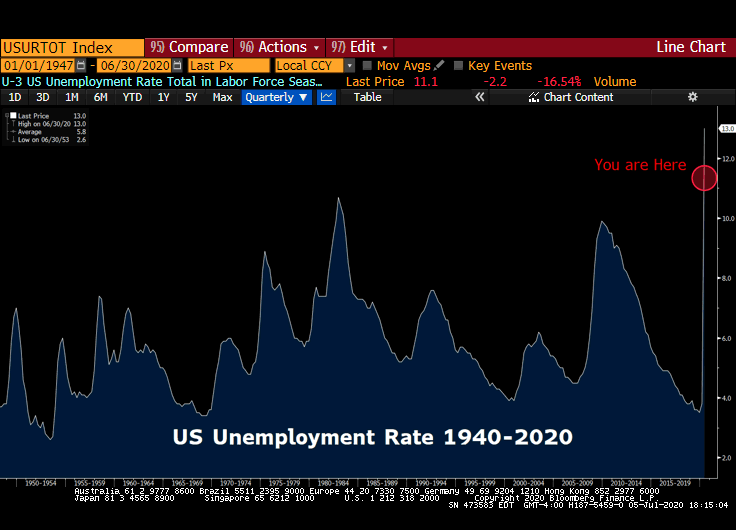 Since January, we have experienced over $4 trillion of deficit spending and $3T of balance sheet expansion from the Federal Reserve. Will the U.S. continue to borrow more, to print more, to stimulate more? A disastrous 11% unemployment number was greeted as a positive surprise. One thing is very clear, a long term sustainable solution is needed to replace the jobs that are NOT coming back.
Since January, we have experienced over $4 trillion of deficit spending and $3T of balance sheet expansion from the Federal Reserve. Will the U.S. continue to borrow more, to print more, to stimulate more? A disastrous 11% unemployment number was greeted as a positive surprise. One thing is very clear, a long term sustainable solution is needed to replace the jobs that are NOT coming back.
“You realize of course, that in order to be eligible for forgiveness of PPP loans, employers HAD to rehire employees by June 30, 2020. After that, if funds provided by CARES have been used for payroll and eligible expenses, the employers have no restriction on future layoffs.”
– John Hussman
Large Hole to Fill
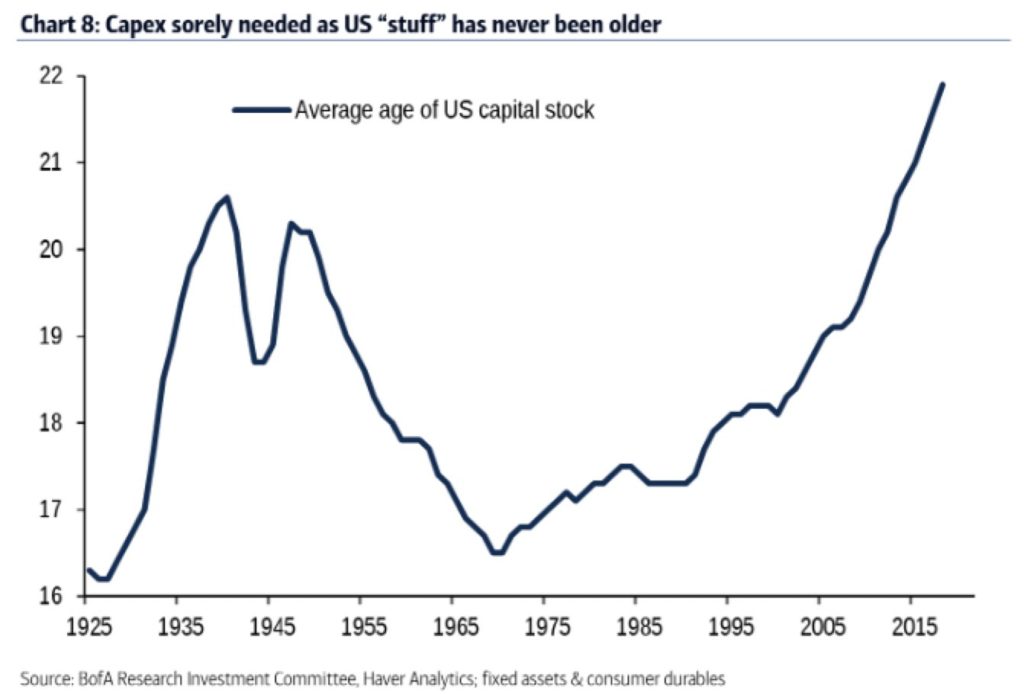 The latest bill passed by the Democrat-controlled House of Representatives concocts a $3 trillion infrastructure bill spending that represents a jump towards a Green New Deal, and unabashedly so. The Republican-controlled Senate knows not what to do: on the one hand, it doesn’t want an infrastructure bill it deems not truly an infrastructure bill, but on the other hand, rejecting what is touted as jobs creating legislation makes for bad optics politically. One would hope that some sort of infrastructure bill slithers out of the Senate before August recess. Assuming a compromise bill is signed in September, then what? Why, more trillions of dollars to state and local governments whose coffers have been emptied by lockdowns. Of course.
The latest bill passed by the Democrat-controlled House of Representatives concocts a $3 trillion infrastructure bill spending that represents a jump towards a Green New Deal, and unabashedly so. The Republican-controlled Senate knows not what to do: on the one hand, it doesn’t want an infrastructure bill it deems not truly an infrastructure bill, but on the other hand, rejecting what is touted as jobs creating legislation makes for bad optics politically. One would hope that some sort of infrastructure bill slithers out of the Senate before August recess. Assuming a compromise bill is signed in September, then what? Why, more trillions of dollars to state and local governments whose coffers have been emptied by lockdowns. Of course.
When it comes to Washington policy, we highly recommend setting up a call with our associates at ACG Analytics. Email tatiana@thebeartrapsreport.com if interested. There has never been a more important time to discuss the political impact on sector rotation in the United States.
The Coming Fiscal Cliff
It’s a scary few words, but all it means is there’s a large amount of fiscal love about to expire, but it sure can be replaced. A robust infrastructure spending agenda is an important option, far more sustainable than sending Americans cash. Some form of an extension of federal unemployment insurance will surely pass in the next piece of legislation. However, the $600 per week “plus up” will not be renewed. Why? Because 70% of recipients now are paid more money NOT to work than the “back to work” option. Usually, there is no federal unemployment pay. Every state has its own parameters for unemployment disbursements. However, currently, we also have a COVID virus inspired federal unemployment payment scheme. This has had a profound effect on the US economy.
Consumer Credit
Over the last 3 months, US consumers have paid down a colossal $106 billion in credit card debt, bring the total outstanding credit card debt below $1 trillion. Indicatively, the first time total credit card debt hit $1 trillion was back in December 2007, which means that the deleveraging of the past 3 months has sent the US credit card balances to a 13 year low. – ZH
So Far, Delinquencies are in Check
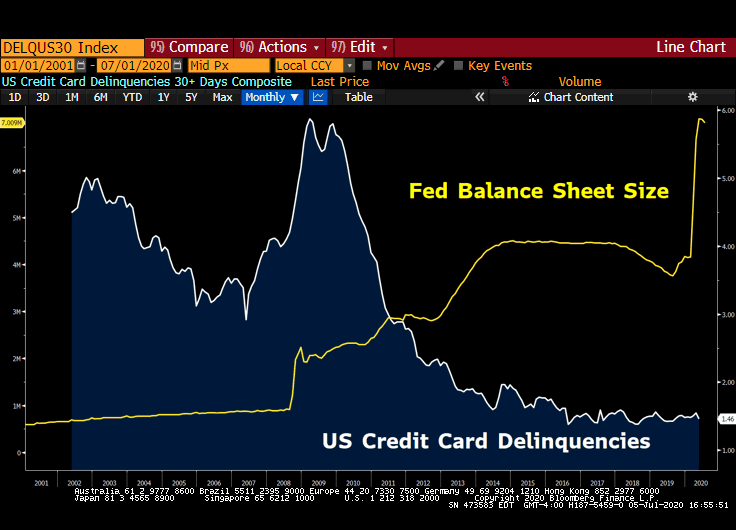 Big credit expansion from the Federal Reserve and a colossal fiscal boost has significantly reduced credit card delinquencies and increased car purchases. Those two phenomena will reverse once the $600 a week safety net vanishes after July 31st. We expect Congress to extend the PPP program for small businesses, but in a more focused format that supports only the hardest-hit businesses. Extending the full $600 per week in Pandemic Unemployment Compensation (PUC) is highly controversial and will NOT last past July.
Big credit expansion from the Federal Reserve and a colossal fiscal boost has significantly reduced credit card delinquencies and increased car purchases. Those two phenomena will reverse once the $600 a week safety net vanishes after July 31st. We expect Congress to extend the PPP program for small businesses, but in a more focused format that supports only the hardest-hit businesses. Extending the full $600 per week in Pandemic Unemployment Compensation (PUC) is highly controversial and will NOT last past July.
Unsustainable Cash Burn
Close to 70% of the U.S. annual budget is already entitlements and interest expense, so laying-out current $600 per week for the roughly 20 million Americans is NOT sustainable. The colossal outlay for those NOT working adds up to $48B a month or $576B a year for the U.S. Government. To put that in perspective, the Defense Budget is $721B this year, and the interest on all of the U.S. Government’s debt is nearly $400B this year (and that’s only the case if the Fed is able to arrest long term interest costs on the U.S. debt obligations). This is clearly an unsustainable unemployment benefit pay-out, but a cliff drop to no benefits could be disastrous. If you take it away, yes you force people back into the labor force, but you also drag down near-term consumption. This is the reason why the Administration is considering ‘bonuses’ to get people to go back to work. The question is what has a stronger effect – Less money in people’s pockets in Q3/Q4 or increased confidence of future income from increased employment? This is another major selling point for infrastructure.
A Must Pass Fiscal Boost for Infrastructure
In brief, and ironically, household income increased in the second quarter as the economy collapsed, and household income will decline as the economy recovers in the third quarter. There will be another bill of over $1 trillion, if only because Senate Republicans know it’s a MUST PASS bill heading into November’s election. They simply have to deliver. As a result, some unemployment benefits will likely be extended to year-end and selected states will be backstopped financially.
As to infrastructure, this has been discussed for well nigh three years now. The House bill insists on broadband for all and Green New Deal lite, while the White House wants classic bridges, tunnels, and roads plus optic fiber everywhere. The whole recipe is a colossal tailwind for construction stocks and a couple of high tech heavyweights. Meanwhile, the Senate is conflicted about more fiscal love and doesn’t know what to do. Timing: perhaps a September signing, right in the middle of the presidential campaign. But any sign that the U.S. economy is potentially strong enough to withdraw fiscal and monetary support, you will see the mother of all taper tantrums. Stock will collapse.
Our High Conviction Call from Early April Here Below
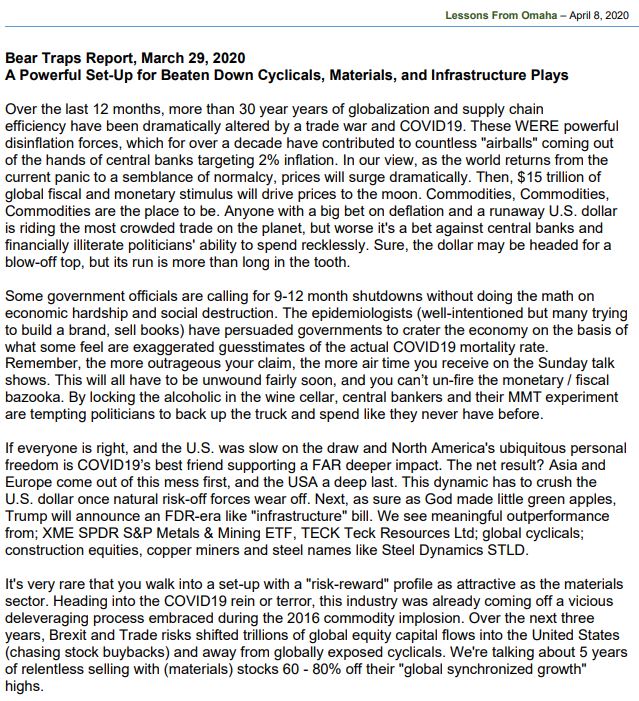 Join us here, just email tatiana@thebeartrapsreport.com
Join us here, just email tatiana@thebeartrapsreport.com
Green New Deal Posing as Infrastructure
The House measure surreptitiously has over $1 trillion of environmental justice programs which are seemingly unrelated to classic infrastructure. A green wolf in infrastructure clothing won’t be embraced by the Republican Senate. But there is another risk: many Republican Senators vowed NOT to raise taxes. The question for them is: how to pay for $1 trillion of infrastructure without raising taxes. The pie is only so big, they argue, but a gas tax is the most likely with a focus on heavy users like Amazon. The answer is new infrastructure grows the pie and so pays for itself over time. As detailed in a previous missive of ours on infrastructure: the improved efficiency of interstate commerce and commute to work times will stimulate the economy enough to generate more tax revenue. Infrastructure should pay for itself in ten years or less. The Department of Transportation is due to release its proposal soon, which we suspect will make exactly that point, which in turn will provide Senate Republicans with exactly the political cover they need.
Political risks to a delay are high and real. Nearly 40% of still employed make less than $40,000 a year. If unemployment remains high, the Democrats may sweep in November.
Normally, infrastructure bills take a long time to hammer together as they are as contentious as they are complicated. One would usually assume it can’t be done quickly. However, the vibrant threat of political extinction is a powerful prod to Republicans to pass infrastructure legislation.
Yet Democrats face their own risks. Why would they hand Trump a major victory before the election? Democrats want to say to their constituents that they passed an environmental bill masquerading as an infrastructure bill. So political risks cut both ways since if Senate Republicans pass their own massive infrastructure bill only to have it rejected by the House, that will be used as a campaign weapon Republicans will use against Democrats. What’s good for the goose is good for the gander. Current betting odds have Democrats doing well come November. But now they have the memory of pain. Polls looked good for Dems the last presidential election cycle. Obviously, they haven’t forgotten.
Biden’s True Love, the Rails
But let us assume no infrastructure bill is passed before election day, and Biden wins. What then? Well, while all of Biden’s policy papers are written by others. Per ACG Analytics in Washington Biden has a long track record of promoting transportation. A train station is named in honor of him. The “Joseph R. Biden, Jr. Railroad Station”, also known as Wilmington station, is one of Amtrak’s busiest stops, serving nine Amtrak trains as it is part of the Northeast Corridor. Further, Dems won’t give up on some kind of Green New Deal, and the Green New Deal, for all its sociological ramifications, has to have a major transportation component, particularly under a Biden stewardship.
Don’t miss our next trade idea. Get on the Bear Traps Report Today, click hereSurging Second Wave Risk Assures Colossal Infrastructure Spending
What would tip the balance in favor of an early infrastructure bill? Worse Covid-19 numbers coupled with a marked slowdown in opening up the economy. The worse the economic news is in the weeks ahead, the more likely an infrastructure bill is in the near term before year-end. Over $8 trillion of U.S. GDP resides in troubled states. The Texas governor, for one, has publicly expressed concern. We note, in passing, that Europe seems to be emerging from lockdowns in a less sloppy manner than is the USA. Their equity markets and the Euro, seemingly, as a result, are performing better than ours.
Copper and Baltic Dry Index are Telling Us Something
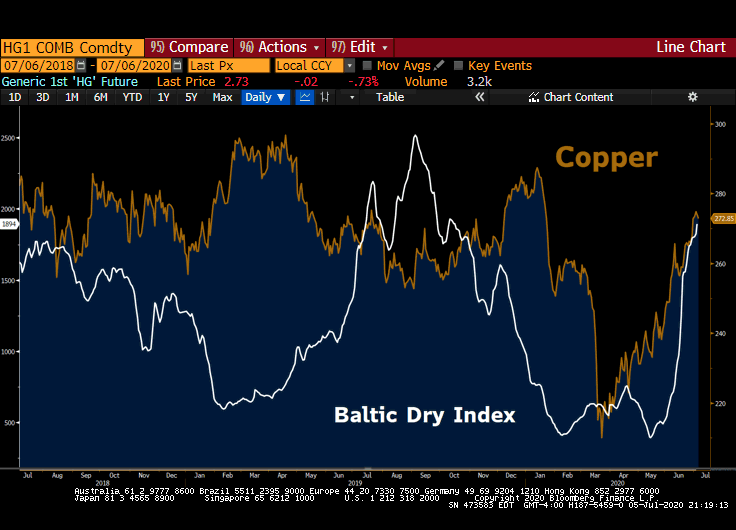 With large fiscal plans coming out of China, the U.S., and the UK, the global commodity complex has caught a bid. Above all, with over $30T in hiding-out in U.S. Treasuries, U.S. Corporate Bonds, and U.S. Big Tech stock certificates, all that PAPER wealth needs an inflation hedge in REAL tangible assets, now MORE than EVER. Bullish commodities.
With large fiscal plans coming out of China, the U.S., and the UK, the global commodity complex has caught a bid. Above all, with over $30T in hiding-out in U.S. Treasuries, U.S. Corporate Bonds, and U.S. Big Tech stock certificates, all that PAPER wealth needs an inflation hedge in REAL tangible assets, now MORE than EVER. Bullish commodities.
Populism’s Next Act Will Demand a Colossal Fiscal Response
We’re face to face with the meta-macroeconomic background of Central Banks providing the groundwork for the rise of populism. For over a decade, central banks have done all the heavy lifting, and now its time to pay the piper. The link isn’t direct. The causal relation isn’t proximate. However, QE is the ground cause behind populism’s rage. By inflating financial assets, wealth inequality has gone through the roof. Fact. Central Bankers’ protestations to the contrary. This has not gone unnoticed by the huddled masses. The concentration of capital, if carried to excess, leads to revolution. Lost in the discussion of this topic is this simple observation: the USA is the only country in the world that has more guns than people, at 120 guns per 100 people, as per the Small Arms Survey conducted in 2017. No other country comes close. If a minority crushes a well-armed majority, the price will be quite high, as history teaches. Social upheavals have been around for as long as we have historical records. The Social War in ancient Rome, for example, lasted from 91BC to 87BC and centered on tribes and cities conquered by Rome 200 years priorly. These peoples were not enfranchised even though they had fought shoulder to shoulder with Romans in the creation of their empire. They believed they should be treated as equals. The Roman Senate disagreed. A devastating civil war ensued, which Rome ultimately won. However, after its victory, the Roman Senate didn’t want to go through another Social War, so the demands for equal citizenship were finally granted. 50,000 Roman men of fighting age fell in the conflict, out of an adult man population of less than 900,000. A similar ratio of men killed for the USA today would number ten million dead. We note that according to the latest polling data, fully a third of Americans believe a Civil War is in the offing. Inequality’s explosion over the last decade nearly guarantees a meaningful infrastructure plan solution.
The Battle for the US Senate
The GOP took 18 Senate seats back in the 2010, 2014, and 2018 elections, a mean reversion shift to the Dems is more than overdue. While the Republicans seem split between those in the Senate who don’t want excess spending, vs. those such as the White House who embraces excess spending, it should be noted that a Democratic sweep would probably lead to but a narrow Senate majority for the Dems and some of the newly anointed will have won narrow victories themselves from States with large conservative populaces. So Republicans will most likely be left with a modicum of leverage. The betting odds for a Democratic takeover of the Senate has increased from 32% to 52%, a remarkable change. The Republicans feel pressure at the state level as well, where more Republican states will have to allow legalized gaming and legal recreational cannabis use to financially survive. States are thirsting for new creative revenue solutions.
Don’t miss our next trade idea. Get on the Bear Traps Report Today, click hereOne unknown is the accuracy of presidential polling. Presidential polls have become notoriously unreliable. Given that few people will admit they are Trump supporters, it is hard to gauge his real support. And even the betting odds are suspect since they report dollars wagered, but Trump supporters make smaller bets because they have less money to wager. So on a numerosity basis, the betting odds are closer. One can say with confidence, however, that directionally Trump’s reelection chances have worsened since the beginning of the year. However, if “only” 35% of the population are die-hard Trump supporters, it is hard to see how ignoring them after a Democratic “landslide” would “heal” the country. But the Democrats plan to not merely ignore Trump voters but to destroy them for the simple reason that progressives utterly despise and disdain them. This is hardly a secret. It should be noted that geographically liberals are in highly concentrated positions with their backs to the water, a fact that would have delighted Augustus Caesar had he found himself in similar circumstances to conservatives today. Geography is destiny, even in a civil war. So: The King is dead! Long live the King! Or as the Who put it in “Won’t Get Fooled Again”: “Meet the new boss. Same as the old boss.” Politics is about power, not justice.
The initial and essential purpose of the lockdown was to flatten the curve so as not to have the hospital system overwhelmed. The result is over forty hospitals have gone bankrupt or have shut down entirely. So while the prospects of an infrastructure bill lifts materials stocks, no one is talking about building new hospitals.
But there is hope. There is hope indeed for a new bipartisan consensus has emerged: China is bad and big tech is bad. One can debate about which political party will address these two issues with greater vigor, but both will cooperate with each other in a fundamental supply chain reconfiguration, and new regulations on and split up of big tech. It is thus conceivable that upcoming legislation on infrastructure will be followed by further significant legislation on more than one front and supported by both parties and the majority of the American people. Generationally, it seems inevitable that more eco-friendly laws will be passed. And there is broad consensus across the electorate that every single citizen, without exception, should be equal under the law. All of these speak to a greater populism that might well unify the country, not divide it. And infrastructure build-out, of both the old and the new, may well lead the way.
When it comes to Washington policy, we highly recommend setting up a call with our associates at ACG Analytics. Email tatiana@thebeartrapsreport.com if interested. There has never been a more important time to discuss the political impact on sector rotation in the United States.
Don’t miss our next trade idea. Get on the Bear Traps Report Today, click here


